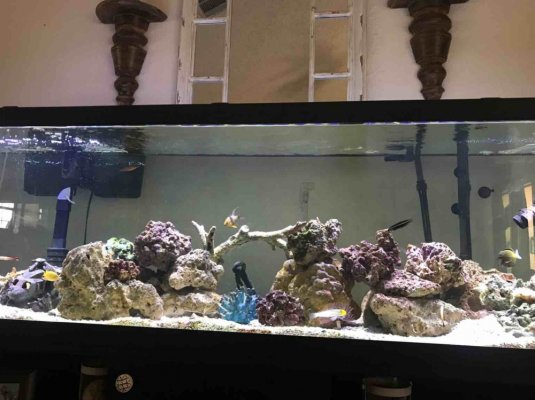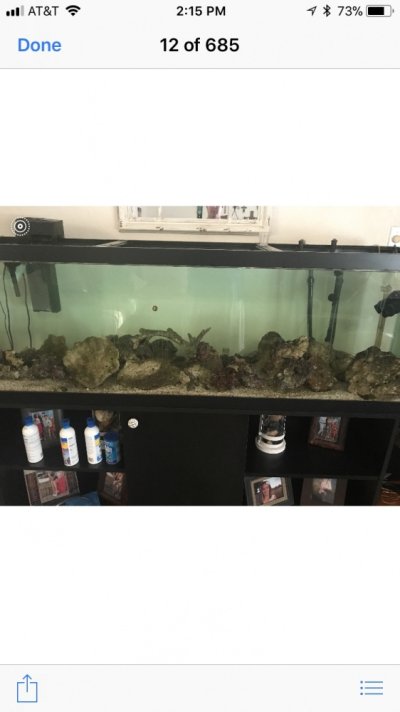So here is how the story goes. We have 3 tanks; 1 a 125 gallon display tank, #2 a 40 gallon tank started in September with a Leopard Wrasse, midnight Blenny, and a small peppermint shrimp, 55 gallon started Nov. 1 (started with 25 gallons of water from # 1, 5 gallons from #2 and about 20 gallons of fresh new water. A little back ground on my history. It’s been 12 years since I had a tank and much has changed, a wet to dry filter system is now called a Refugium. Under gravel filters are not talked about much and the hobby can still be expensive. I have at least 50 pnds of gravel ( and a UG filter) with another 60 pnds probably of live rock, a HOB penguin bio wheel filter and a Cascade power filter. (Yes old school, but advancing).
pH 8.2
Ammonia-0 liquid
Nitrate- 0 to low strips
Nitrite-0 to low strip
Ca- not tested
Phos- not tested only wish I could
PWC every two to 3 weeks.
Mild mannered fish about 17, 3 to 4 inch fish.
I know some of you may say too many fish for the tank size. Argue all you want no one knows for sure and I use an accepted equation of 5 gallons of water/3” of fish with plenty of rock for hiding. The water has never tested bad the fish appear happy and filters do not seem stressed.
.
I was getting ready for my water Change when I noticed a dead fish our largest, Powder Brown Tang 4 inches. Previous night showed absolutely no problems swimming eating and appeared healthy. Still did not appear to have anything wrong visibly just thought maybe the infamous tang death. As the day went on upon close inspection of the fish we noticed that a Damsel was acting funny stressed with color faded swimming a bit radically. We noticed it swimming into the flow of the power head which was odd. We then saw it on our Hawaiian Trigger a dust coat with tiny whitish spots. Then on our bicolor Angel a dusty film. Research ensued. After awhile of reading we determined a poor dx of SALTWATER VELVET. Nothing good. No good out comes. We began to scramble and talk with the LFS who we have a great relationship with.
pH 8.2
Ammonia-0 liquid
Nitrate- 0 to low strips
Nitrite-0 to low strip
Ca- not tested
Phos- not tested only wish I could
PWC every two to 3 weeks.
Mild mannered fish about 17, 3 to 4 inch fish.
I know some of you may say too many fish for the tank size. Argue all you want no one knows for sure and I use an accepted equation of 5 gallons of water/3” of fish with plenty of rock for hiding. The water has never tested bad the fish appear happy and filters do not seem stressed.
.

I was getting ready for my water Change when I noticed a dead fish our largest, Powder Brown Tang 4 inches. Previous night showed absolutely no problems swimming eating and appeared healthy. Still did not appear to have anything wrong visibly just thought maybe the infamous tang death. As the day went on upon close inspection of the fish we noticed that a Damsel was acting funny stressed with color faded swimming a bit radically. We noticed it swimming into the flow of the power head which was odd. We then saw it on our Hawaiian Trigger a dust coat with tiny whitish spots. Then on our bicolor Angel a dusty film. Research ensued. After awhile of reading we determined a poor dx of SALTWATER VELVET. Nothing good. No good out comes. We began to scramble and talk with the LFS who we have a great relationship with.

